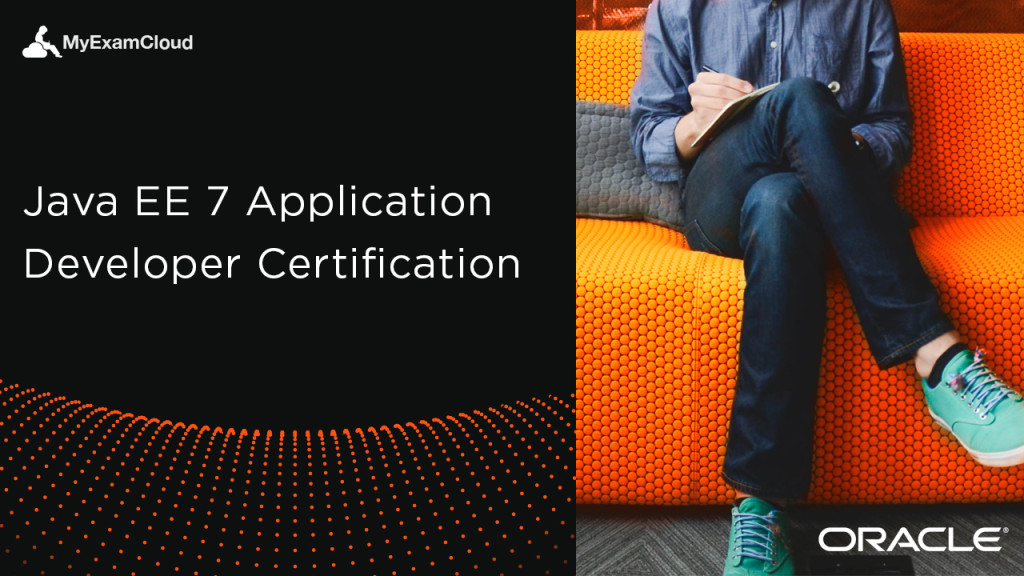Oracle recently launched Java EE 7 Application Developer Certification to cover majority of Java EE components and APIs. The new certification does not require any prerequisite and any Java EE aspirants can take this certification.
Exam Details
| Exam Duration | : | 150 Minutes |
| Number of Questions | : | 70 Questions |
| Passing Score | : | 66% |
| Format | : | Multiple Choice |
The exam covers Java EE 7 new additions like Web Sockets, Concurrency API and Batch API along with core components.
Exam Objectives
Understand Java EE Architecture
- Describe Java EE 7 standards, containers, APIs, and services
- Differentiate between application component functionalities as they apply to different tiers and containers, including Java EE Web Container, Business Logic implementation and WebServices
- Create, package and deploy Java EE application
- Demonstrate understanding of Enterprise JavaBeans and CDI beans, their lifecycle and memory scopes
- Demonstrate understanding of the relationship between bean components, annotations, injections, and JNDI
Manage Persistence using JPA Entities and BeanValidation
- Create JPA Entity and Relationship Object-Relational Mappings (ORM)
- Use Entity Manager to perform database operations, transactions and locking with JPA entities
- Handle entity data with conversions, validations, and key generation
- Create and execute JPQL statements
Implement Business Logic by Using EJBs
- Create session EJB components containing synchronous and asynchronous business methods, manage the life cycle container callbacks and use interceptors
- Demonstrate understanding of how to control EJB transactions, distinguish Container Managed (CMT) and Bean Managed (BMT) transactions
- Create EJB timers
Use Java Message Service API
- Describe the Java Message Service (JMS) messaging models and implement Java SE and Java EE message producers and consumers, including Message-Driven beans
- Use transactions with JMS API
Implement SOAP Services by Using JAX-WS and JAXB APIs
- Create SOAP Web Services and Clients using JAX-WS API
- Define Java to XML Schema mappings to marshall and unmarshall Java Objects by using JAXB API
Create Java Web Applications using Servlets
- Create Java Servlets, describe how they are mapped to urls and use HTTP methods
- Handle HTTP headers, parameters, cookies
- Manage servlet life cycle with container callback methods and WebFilters
Create Java Web Applications using JSPs
- Describe JSP life cycle
- Describe JSP syntax, use tag libraries and Expression Language (EL)
- Handle errors using Servlets and Java Server Pages
Implement REST Services using JAX-RS API
- Understand and Apply REST service conventions
- Create REST Services and clients using JAX-RS API
Create Java Applications using WebSockets
- Understand and utilise WebSockets communication style and lifecycle
- Create WebSocket Server and Client Endpoint Handlers using JSR 356 API and JavaScript
- Produce and consume, encode and decode WebSocket messages
Develop Web Applications using JSFs
- Describe JSF arcitecture, lifecycle and navigation
- Understand JSF syntax and use JSF Tag Libraries
- Handle localisation and produce messages
- Use Expression Language (EL) and interact with CDI beans
Secure Java EE 7 Applications
- Describe Java EE declarative and programmatic security and configure authentication using application roles and security constraints and Login Modules
- Describe WebServices security standards
Use CDI Beans
- Create CDI Bean Qualifiers, Producers, Disposers, Interceptors, Events and Stereotypes
Use Concurrency API in Java EE 7 Applications
- Demonstrate understanding of Java Concurrency Utilities and use Managed Executors
Use Batch API in Java EE 7 Applications
- Describe batch jobs using JSL XML documents and JSR 352 API
Books and Preparation Resources
The MyExamCloud team planned to launch Java EE 7 Application Developer certification Training contents, books and Practice Tests by July 1st week. Keep watching MyExamCloud web app or blogs.
 Java EE 7 Application Developer Certification
Java EE 7 Application Developer Certification


